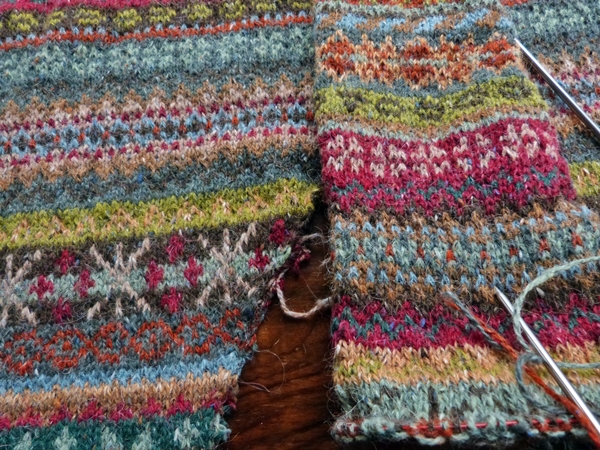 Yesterday I was working on the second sleeve of my Orkney cardigan when the following exchange happened.
Yesterday I was working on the second sleeve of my Orkney cardigan when the following exchange happened.
Passer-by: Hey, what are you doing? Me: Oh, I'm working on this fair-isle cardigan.. Passer-by: Oh no! That's not fair-isle. You are not from Shetland. You cannot be knitting fair-isle. I am from Shetland and I am telling you that you cannot work fair-isle. Me: .. uhmm, okay?
This led to an interesting discussion on Twitter about geographical locations, if any non-Shetlanders are allowed to say their stranded colourwork is fair-isle (and if it is fair isle, Fair Isle or Fair-Isle) and if we are able to talk about "traditional knitting" at all. Here are some selected highlights:
@kariebookish "Being from" is surely not a thing for trademark purposes? Cf Harris Tweed which *is* protected by law: http://t.co/6AfGtVoyuO
— Norbert Roomboter (@vonbladet) March 11, 2014
(Great point! Can a technique or motif be geographically trademarked?) Some snarky comments from amused knitters:
@kariebookish Does that also mean that non-Norwegians can't do Norwegian purl?
— Christina (@stinaest) March 11, 2014
@kariebookish Better throw out my shaw with nupps in it since I'm not Estonian.
— Vanessa (@MMAAC) March 11, 2014
@kariebookish so what should all of us non-shetlanders call the technique, given that we probably outnumber shetlanders #nomorefairisle
— Vickie Glynn (@VicksG) March 11, 2014
@kariebookish @VivienneU Or people who live there but weren't born there? What's the minimum number of generations?
— Kate Heppell (@KateHeppell) March 11, 2014
And, finally, less snarkily and more to the point:
@kariebookish fixing of traditions being largely a marketing device that contradicts the approach of the knitters who developed them — Ysolda Teague (@ysolda) March 12, 2014
I am interested in the socio-political aspects of so-called traditional knitting: there is definitely a discussion to be had about what constitutes a tradition - who decides something is a tradition - and if we can talk about origins at all. Motifs and techniques have criss-crossed geographical boundaries and what we may think of as "traditional knitting" may only date back to the early 20th century. My personal view is that all these things only tend to be "fixed" in time and place long after actual innovation has occurred - and that many of these "fixes" have little to do with the actual innovations and more to do with money/prestige.
It's a fascinating topic and I wish I had a fresh mind with which to tackle it (alas, I am writing this after working all day on another piece of writing). I'll keep knitting my Orkney, mind. Only half a sleeve to go and I refuse to leave it alone despite my personal geographical failings.
